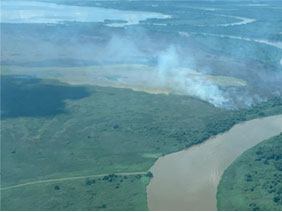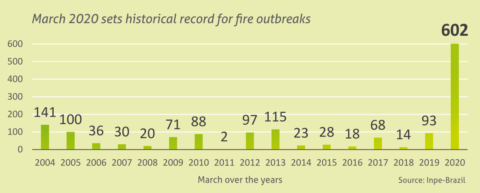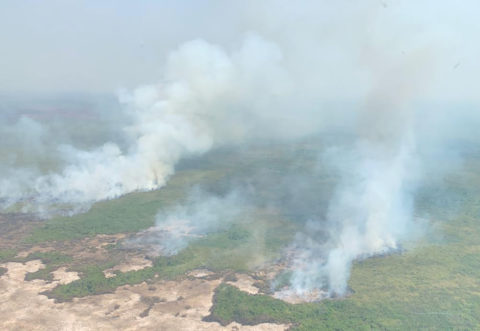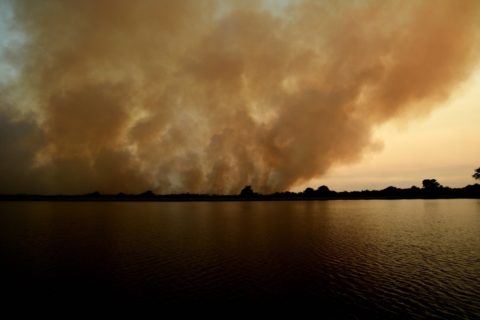
March registers a record number of fires in the Pantanal
-
Corredor Azul
There were 602 fires this year against 141 in March 2004, the second-highest record in history.
“March waters”, as Brazilians call it, haven’t showered to close the summer in 2020. Spare rains, dry weather, and thermal radiation contributed to a record number of fires in the Pantanal. In March, 602 fire outbreaks hit the region, according to the National Institute for Space Research (Inpe – Brazil).
This number is 547% higher than the same period last year, when 93 fire outbreaks were registered, surpassing the peak in 2004, the year that had 141 fires, and which now becomes the second largest number since when Inpe began recording fires in Brazil’s biomes in 1998.
Corumbá (Mato Grosso do Sul State), remains the city with the highest number of fires in Brazil: there were 650 from January 1st to March 31st. Poconé (Mato Grosso), which is also located in Pantanal floodplain, recorded 240 fires during the last month. In the first quarter of 2020, 1,031 occurrences were registered, against 641 in 2019, an increase of 60%.

Wetlands International Brazil follows this exponential increase and publishes information on the situation weekly on social networks (Facebook and Twitter) and the website.
There were 545 recorded in our last report by March 25. 57 new outbreaks appeared in the last week of the month. There are 438 new records compared to February this year, when 164 fires occurred. Fire contributes to the greenhouse effect of climate change, it degrades natural habitats and it affects biodiversity, in addition to putting the health of people living in the region at risk.
Origins of fire
Large fires do not show a single cause, it is scaled by a combination of factors. It can be from the fire used for cattle management getting out of control to open fires by tourists and fishermen near areas of human concentration or fishing grounds and around cities. Even fires that start along the roads and banks of the river that are later spread by dry organic matter and winds, that all among other origins.
According to Fábio Catarineli, lieutenant colonel of the Fire Brigade, coordinator of the Civil Defense of the State and member of the coordination of the “Integrated Situation Room”, where federal and state bodies join in the monitoring and carry out inspection, prevention and fire fighting actions. Much of that fire is caused by human action. “Statistically speaking, about 90% of fires are caused by man. Sometimes it is caused by people who use the area for hunting or fishing, but we are hardly able to catch them in action “, he says.
Another factor that contributes to this exponential increase is the lack of rain and the low intensity when they happen in the region. According to the National Institute of Meteorology (Inmet) there were 48mm of precipitation during the third month of 2020, with the first rain occurring on March 13, and in the last week of the month only 6mm was recorded. In the same period last year it rained 58mm.
In the coming months, the tendency is for less rain
For April and the following months, Catarineli is categorical in saying that the tendency is for less rain to occur. “We are leaving the rainy season and historically it starts with less and less precipitation and when it rains there is a low volume of water”, he points out. “The peak of the fires in September which is a month with little rain and also when big forest fires happen. Due to this, we are already developing actions to reduce this year’s impact”, he points out.
The accumulation of dry vegetation from previous years also exacerbates the situation. “Pantanal has this characteristic, then the vegetation grows from above. When we flew over the region in mid-March we saw that the fire was under the green. This comes from the concentrated fuel material”, he explains.

Burning damages the environment, the economy as well as the human health
Uncontrolled fire causes several environmental, economic and human health damages, such as the increased release of carbon dioxide, one of the main causes of global warming; destruction of natural habitats; soil erosion; pollution of springs, groundwater and rivers through ashes; species extinction (fauna and flora); loss of ecosystem services (forage production, water quality, carbon stock, among others); destruction of fences; as well as higher incidence of respiratory diseases.
Nature is severely damaged by uncontrolled fire. “In Pantanal the vegetation in cerrado areas is generally adaptable to fire unlike vegetation in flooded areas. In wet areas fire-sensitive species will be affected and less sensitive species such as thorns will appear. The recovery of such species will depend on the time of year (climatic conditions) and post-burning management”, explains Sandra Aparecida Santos, a researcher on sustainable animal production at Embrapa Pantanal.
Fires in Pantanal still cause several losses to farmers. “Large fires burn extensive pasture areas that reduce the carrying capacity of the pastures, making it necessary to buy food to keep the cattle or to remove/decrease the herd. Depending on the severity of the fire, the cattle may die. On a large scale there are also losses of biodiversity and ecosystem services “, warns Sandra.
Human health is also affected by fires. According to pulmonologist Andréa Cunha, combustion can cause respiratory diseases and exacerbate these diseases in those who already have a predisposition. “In this sense, smoke can cause diseases ranging from irritative, allergic, and contagious and predispose those who have these problems. It facilitates asthma attacks, rhinitis, and emphysema. People who have respiratory diseases, the elderly and children are more likely to be affected “, he says.

Irritation of the upper airways caused by inhaled particles due to increased temperatures and pollution caused by fires can even facilitate the spread of COVID-19. “This irritation increases the secretion that is more lush, so viruses and bacteria have a place to stay and settle. The burn can predispose the person to have inflammation in the respiratory airways, even caused by the coronavirus “, he warns.
Integrated Situation Room promotes actions to fight fire
Some measures are already being taken to try to reverse this atypical March: activation of the Integrated Situation Room; the Drought Plan was released to the Fire Department on Wednesday (1st); awareness campaigns are being prepared; brigade courses are being taught. “People awareness, which protects and preserves the environment, is the only possible thing that will bring results. It takes a few years for these numbers to decrease, but we have faith that this will happen “, reflects the lieutenant colonel of the Fire Department.
The world pandemic and the state of public calamity established in the country due to COVID-19 influence the work of the inspection and fire-fighting agencies, but they have not reduced services. “The meetings of the Integrated Situation Room are being held via the internet, but the vacations of any member of the corporation have been suspended, so we are fully staffed both for health and environmental demands”, guarantees Catarineli.
We commend the determination and perseverance of the Fire Department and the bodies that are part of the Integrated Situation Room, which, even amid a global pandemic, continue to carry out the work of conserving the environment by fighting the fire. We hope that the averages being developed will be effective and that the number of fires in 2020 will be less than in the last year.
In an open letter published by Wetlands International on October 29, 2019, other reasons were pointed out that increase the fires: cut the budget by IBAMA and INPE, late reaction by a reduced capacity fire department, lack of action by the government to mobilize state strength to control fire and lack of human capacity for fire management practices appropriate for the region. We expect energetic and effective measures from public agencies to reverse this situation. The full letter can be accessed here.
___________
Photos of Instituto Homem Pantaneiro (IHP)
